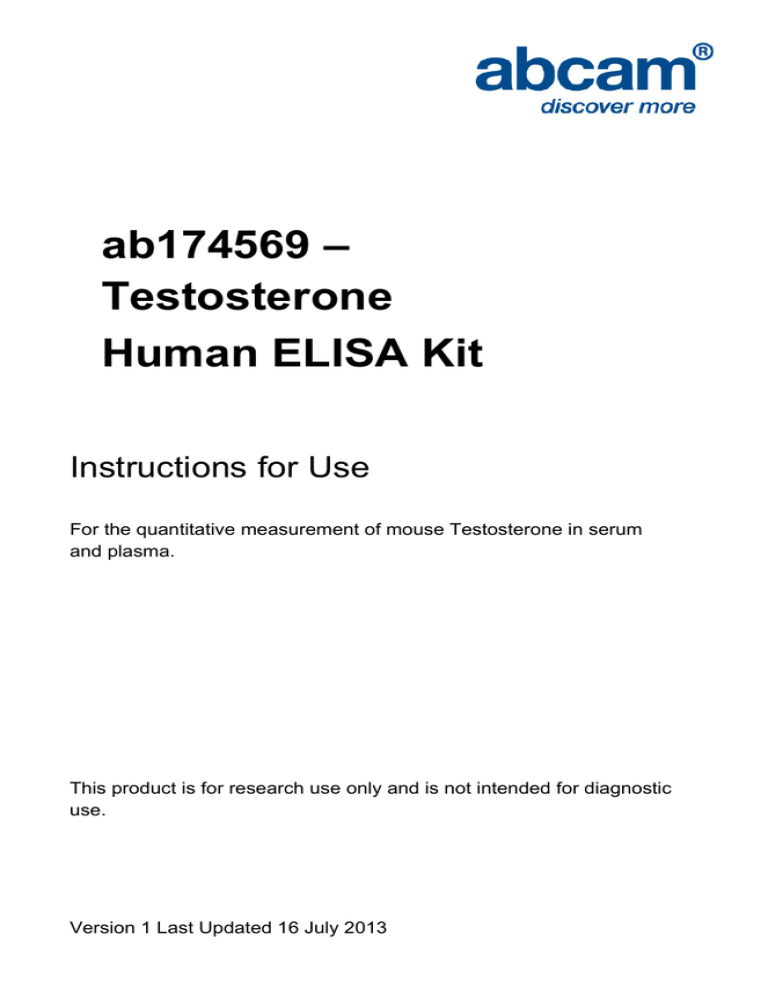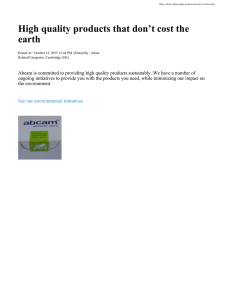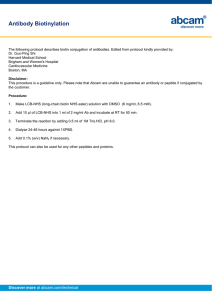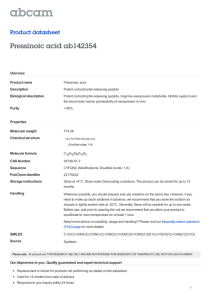
ab174569 –
Testosterone
Human ELISA Kit
Instructions for Use
For the quantitative measurement of mouse Testosterone in serum
and plasma.
This product is for research use only and is not intended for diagnostic
use.
Version 1 Last Updated 16 July 2013
Table of Contents
INTRODUCTION
1.
BACKGROUND
2
2.
ASSAY SUMMARY
3
GENERAL INFORMATION
3.
PRECAUTIONS
4
4.
STORAGE AND STABILITY
4
5.
MATERIALS SUPPLIED
4
6.
MATERIALS REQUIRED, NOT SUPPLIED
5
7.
LIMITATIONS
5
8.
TECHNICAL HINTS
5
ASSAY PREPARATION
9.
REAGENT PREPERATION
6
10.
SAMPLE PREPARATION
6
ASSAY PROCEDURE
11.
ASSAY PROCEDURE
8
DATA ANALYSIS
12.
CALCULATIONS
9
13.
TYPICAL DATA
10
14.
TYPICAL SAMPLE VALUES
10
15.
ASSAY SPECIFICITY
13
RESOURCES
16.
TROUBLESHOOTING
14
17.
NOTES
15
Discover more at www.abcam.com
1
INTRODUCTION
1. BACKGROUND
Testosterone Human ELISA Kit is a solid phase enzyme-linked
immunosorbent assay (ELISA), based on the principle of competitive
binding. The microtiter wells are coated with a monoclonal [mouse]
antibody directed towards a unique antigenic site on the Testosterone
molecule. Endogenous Testosterone of a sample competes with a
Testosterone horseradish peroxidase conjugate for binding to the
coated antibody. After incubation the unbound conjugate is washed off.
The amount of bound peroxidase conjugate is reverse proportional to
the concentration of Testosterone in the sample. After addition of the
substrate solution, the intensity of colour developed is reverse
proportional to the concentration of Testosterone in the sample.
Discover more at www.abcam.com
2
INTRODUCTION
2. ASSAY SUMMARY
*Please follow full Assay Procedure, this section is purely a
summary.
Prepare all reagents and samples as instructed.
Add calibrator, control and samples to each well used. Incubate at
room temperature
Add Enzyme Conjugate to each well. Incubate at room temperature.
Add Substrate solution. Incubate at room temperature.
Add Stop Solution to each well. Read at 450nm.
Discover more at www.abcam.com
3
GENERAL INFORMATION
3. PRECAUTIONS
Please read these instructions carefully prior to beginning the
assay.
Modifications to the kit components or procedures may result in loss of
performance.
4. STORAGE AND STABILITY
Store kit at 2°C to 8°C immediately upon receipt.
Refer to list of materials supplied for storage conditions of individual
components. Microtiter wells must be stored at 2 °C - 8 °C. Once the
foil bag has been opened, care should be taken to close it tightly
again.
Observe the storage conditions for individual prepared
components in section 9. Reagent Preparation.
5. MATERIALS SUPPLIED
Item
Testosterone Microplate (12 x 8 break apart
strips)
40X Wash Solution Concentrate
Calibrators (#0-6, 1ml each)
HRP Conjugate
Chromogenic TMB Solution
Stop Solution
Discover more at www.abcam.com
Amount
Storage
Condition
(Before
Preparation)
96 wells
2°C - 8°C
30 mL
7 vials
25 mL
25 mL
14 mL
2°C - 8°C
2°C - 8°C
2°C - 8°C
2°C - 8°C
2°C - 8°C
4
GENERAL INFORMATION
6. MATERIALS REQUIRED, NOT SUPPLIED
These materials are not included in the kit, but will be required to
successfully utilize this assay:
Microplate reader capable of measuring absorbance at
450±10 nm.
Calibrated variable precision micropipettes.
Absorbent paper.
Distilled or deionized water.
Semi logarithmic graph paper or computer and software for ELISA
data analysis.
Timer.
7. LIMITATIONS
Do not mix or substitute reagents or materials from other kit lots or
vendors.
8. TECHNICAL HINTS
All reagents and specimens must be allowed to come to room
temperature before use. All reagents must be mixed without
foaming.
Once the test has been started, all steps should be completed
without interruption.
Use new disposal plastic pipette tips for each calibrator, control or
sample in order to avoid cross contamination.
Absorbance is a function of the incubation time and temperature.
Before starting the assay, it is recommended that all reagents are
ready, caps removed, all needed wells secured in holder, etc. This
will ensure equal elapsed time for each pipetting step without
interruption.
As a general rule the enzymatic reaction is linearly proportional to
time and temperature.
Discover more at www.abcam.com
5
ASSAY PREPARATION
9. REAGENT PREPARATION
Equilibrate all reagents to room temperature (18-25°C) prior to use.
Wash Solution
Add deionized water to the 40X concentrated Wash Solution. Dilute
30 mL of concentrated Wash Solution with 1170 mL deionized water to
a final volume of 1200 mL.
The diluted Wash Solution is stable for 2 weeks at room
10. SAMPLE PREPARATION
General Sample Information:
Serum or plasma (EDTA-, Heparin- or citrate plasma) can be used
in this assay.
Do not use haemolytic, icteric or lipaemic specimens.
Please note: Samples containing sodium azide should not be used
in the assay.
10.1
Specimen Collection
Serum: Collect blood by venipuncture, allow to clot, and
separate serum by centrifugation at room temperature. Do not
centrifuge before complete clotting has occurred. Patients
receiving anticoagulant therapy may require increased clotting
time.
Plasma: Whole blood should be collected into centrifuge tubes
containing anti coagulant and centrifuged immediately after
collection.
10.2
Specimen Storage and Preparation
Specimens should be capped and may be stored for up to 5
days at 2-8°C prior to assaying.
Specimens held for a longer time should be frozen only once
at -20°C prior to assay. Thawed samples should be inverted
several times prior to testing.
Discover more at www.abcam.com
6
ASSAY PREPARATION
10.3
Specimen Dilution
If in an initial assay, a specimen is found to contain
testosterone more than the highest calibrator, the specimens
can be diluted with Calibrator 0 and reassayed as described in
Assay Procedure. For the calculation of the concentrations this
dilution factor has to be taken into account.
Example:
a) Dilution 1:10: 10 µL Serum + 90 µL Calibrator 0 (mix
thoroughly)
b) Dilution 1:100: 10 µL dilution a) 1:10 + 90 µL Calibrator 0
(mix thoroughly).
Discover more at www.abcam.com
7
ASSAY PROCEDURE
11. ASSAY PROCEDURE
Equilibrate all materials and prepared reagents to room
temperature (18 - 25°C) prior to use.
Each run must include a calibration curve.
11.1
Secure the desired number of Microtiter wells in the holder.
11.2
Dispense 25 μL of each Calibrator, Control and sample with
new disposable tips into appropriate wells.
11.3
Dispense 200 µL Enzyme Conjugate into each well.
Thoroughly mix for 10 seconds. It is important to have a
complete mixing in this step.
11.4
Incubate for 60 minutes at room temperature (without
covering the plate).
11.5
Briskly shake out the contents of the wells. Rinse the wells 3
times with diluted Wash Solution (400 μL per well). Strike the
wells sharply on absorbent paper to remove residual droplets.
Important note: The sensitivity and precision of this assay is
markedly influenced by the correct performance of the washing
procedure!
11.6
Add 200 μL of Substrate Solution to each well.
11.7
Incubate for 15 minutes at room temperature.
11.8
Stop the enzymatic reaction by adding 100 μL of Stop
Solution to each well.
11.9
Determine the absorbance (OD) of each well at 450 ± 10 nm
with a microtiter plate reader. It is recommended that the wells
be read within 10 minutes after adding the Stop Solution.
Discover more at www.abcam.com
8
DATA ANALYSIS
12. CALCULATIONS
Calculate the average absorbance values for each set of
calibrators, controls and patient samples.
Construct a calibration curve by plotting the mean absorbance
obtained from each calibrator against its concentration with
absorbance value on the vertical(Y) axis and concentration on the
horizontal (X) axis.
Using the mean absorbance value for each sample determine the
corresponding concentration from the calibration curve.
Automated method: The results in the IFU have been calculated
automatically using a 4 PL (4 Parameter Logistics) curve fit.
Parameter Logistics is the preferred method. Other data reduction
functions may give slightly different results.
The concentration of the samples can be read directly from this
calibration curve. Samples with concentrations higher than that of
the highest calibrator have to be further diluted or reported as
> 16 Ing/mL. For the calculation of the concentrations this dilution
factor has to be taken into account.
Discover more at www.abcam.com
9
DATA ANALYSIS
13. TYPICAL DATA
TYPICAL STANDARD CURVE – Data provided for demonstration
purposes only. A new standard curve must be generated for each
assay performed.
Calibrator
Number
Conc.
(ng/mL)
Optical Units
(450 nm)
0
0
2.1
1
0.2
1.71
2
0.5
1.44
3
1
1.18
4
2
0.89
5
6
0.46
6
16
0.24
EXPECTED NORMAL VALUES - It is strongly recommended that
each laboratory should determine its own normal and abnormal values.
In a study conducted with apparently normal healthy adults, using this
kit the following values were observed:
Population
5% Percentile
(ng/mL)
95% Percentile
(ng/mL)
Males
Females
2.0
0.26
6.9
1.22
14. TYPICAL SAMPLE VALUES
SENSITIVITY –
The analytical sensitivity of the Testosterone Human ELISA Kit was
calculated by subtracting 2 standard deviations from the mean of 20
replicate analyses of the Zero Calibrator and was found to be
0.0083 ng/mL.
Discover more at www.abcam.com
10
DATA ANALYSIS
RECOVERY –
Samples have been spiked by adding Testosterone solutions with
known concentrations in a 1:1 ratio. The expected values were
calculated by addition of half of the values determined for the undiluted
samples and half of the values of the known solutions. The %
Recovery has been calculated by multiplication of the ratio of the
measurements values and the expected values with 100.
Sample
Added
Concentration
1:1 (v/v)
(ng/mL)
Measured
Conc.
(ng/mL)
Expected
Conc.
(ng/mL)
Recovery
(%)
1
0.0
16.0
6.0
2.0
1.0
1.1
9.31
3.93
1.67
0.91
8.55
3.55
1.55
1.05
109.0
110.7
107.9
86.9
2
0.0
16.0
6.0
2.0
1.0
6.07
11.81
6.65
3.73
3.26
11.03
6.03
4.03
3.53
107.1
110.1
92.5
92.2
3
0.0
16.0
6.0
2.0
1.0
11.62
14.76
9.33
7.29
6.75
13.81
8.81
6.81
6.31
108.3
108.1
110.0
110.1
Discover more at www.abcam.com
11
DATA ANALYSIS
LINEARITY OF DILUTION Sample
Dilution
Measured
Expected
Recovery
Conc
Conc
(%)
(ng/mL)
(ng/mL)
1.10
0.51
0.24
0.15
6.07
3.36
1.66
0.68
0.37
11.26
5.76
2.76
1.55
0.77
1.10
0.55
0.27
0.14
6.07
3.03
1.52
0.76
0.38
11.26
5.63
2.81
1.41
0.70
None
1:2
1:4
1:8
None
1:2
1:4
1:8
1:16
None
1:2
1:4
1:8
1:16
1
2
3
93.8
86.1
106.6
110.6
109.2
89.0
97.0
102.4
97.9
110.0
109.5
PRECISION –
Intra Assay Variation - The within assay variability is shown below:
Sample
n
Mean (ng/mL)
CV (%)
1
20
0.73
4.16
2
20
4.88
3.28
3
20
11.26
3.34
Inter Assay Variation – The between assay variability is shown
below:
Sample
n
Mean (ng/mL)
CV (%)
1
20
0.82
9.94
2
20
5.20
6.71
3
20
11.38
4.73
Discover more at www.abcam.com
12
DATA ANALYSIS
ASSAY DYNAMIC RANGE - The range of the assay is between
0.083 – 16 ng/mL.
15. ASSAY SPECIFICITY
Cross Reactivity:
Analyte
Cross
Reactivity
Testosterone
100
5α-Dihydrotestosterone
0.8
Androstenedione
0.9
11α-Hydroxyestosterone
3.3
17α-Methyltestosterone
0.1
19-Nortestosterone
3.3
Epitestosterone
< 0.1
Oestradiol
< 0.1
Progesterone
< 0.1
Cortisol
< 0.1
Oestrone
< 0.1
Danazol
< 0.1
Interfering Substances:
Haemoglobin (up to 4 mg/mL), Bilirubin (up to 0.25 mg/mL) and
Triglyceride (up to 7.5 mg/mL) have no influence on the assay results.
Drug Interferences:
Until today no substances (drugs) are known to us, which have an
influence to the measurement of Testosterone in a sample.
High-Dose-Hook Effect:
No hook effect was observed in this test.
Discover more at www.abcam.com
13
RESOURCES
16. TROUBLESHOOTING
Problem
Poor
standard
curve
Low Signal
Large CV
Cause
Solution
Inaccurate pipetting
Check pipettes
Improper standards
dilution
Prior to opening, briefly spin the
stock standard tube and dissolve
the powder thoroughly by gentle
mixing
Incubation times too
brief
Ensure sufficient incubation times;
change to overnight
standard/sample incubation
Inadequate reagent
volumes or improper
dilution
Check pipettes and ensure correct
preparation
Inaccurate pipetting
Check pipettes
Plate is insufficiently
washed
Review manual for proper wash
technique. If using a plate
washer, check all ports for
obstructions
Contaminated wash
buffer
Prepare fresh wash buffer
Improper storage of
the ELISA kit
Check the storage instructions.
Keep substrate solution protected
from light.
High
background
Low
sensitivity
Discover more at www.abcam.com
14
RESOURCES
17. NOTES
Discover more at www.abcam.com
15
RESOURCES
Discover more at www.abcam.com
16
RESOURCES
Discover more at www.abcam.com
17
RESOURCES
Discover more at www.abcam.com
18
UK, EU and ROW
Email: technical@abcam.com | Tel: +44-(0)1223-696000
Austria
Email: wissenschaftlicherdienst@abcam.com | Tel: 019-288-259
France
Email: supportscientifique@abcam.com | Tel: 01-46-94-62-96
Germany
Email: wissenschaftlicherdienst@abcam.com | Tel: 030-896-779-154
Spain
Email: soportecientifico@abcam.com | Tel: 911-146-554
Switzerland
Email: technical@abcam.com
Tel (Deutsch): 0435-016-424 | Tel (Français): 0615-000-530
US and Latin America
Email: us.technical@abcam.com | Tel: 888-77-ABCAM (22226)
Canada
Email: ca.technical@abcam.com | Tel: 877-749-8807
China and Asia Pacific
Email: hk.technical@abcam.com | Tel: 108008523689 (中國聯通)
Japan
Email: technical@abcam.co.jp | Tel: +81-(0)3-6231-0940
www.abcam.com | www.abcam.cn | www.abcam.co.jp
Copyright © 2013 Abcam, All Rights Reserved. The Abcam logo is a registered trademark.
All information / detail is correct at time of going to print.
RESOURCES
19



![Anti-DR4 antibody [B-N28] ab59481 Product datasheet Overview Product name](http://s2.studylib.net/store/data/012243732_1-814f8e7937583497bf6c17c5045207f8-300x300.png)
![Anti-FAT antibody [Fat1-3D7/1] ab14381 Product datasheet Overview Product name](http://s2.studylib.net/store/data/012096519_1-dc4c5ceaa7bf942624e70004842e84cc-300x300.png)
